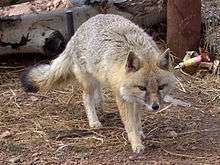List of the Cenozoic life of Kansas
This list of the Cenozoic life of Kansas contains the various prehistoric life-forms whose fossilized remains have been reported from within the US state of Kansas and are between 66 million and 10,000 years of age.
A
- Acris
- †Acris crepitans
- †Adelphailurus
- †Adelphailurus kansensis – type locality for species
- †AelurodonFossilized skull of the Miocene bone-crushing dog Aelurodon
- †Aelurodon taxoides
- Agkistrodon
- †Agkistrodon contortix
- †Agriocharis
- †Agriocharis progenes – type locality for species
- †Agriotherium
- †Alforjas
- †Alforjas taylori
- †Alilepus
- †Alilepus hibbardi
- †Allogona
- †Allophaiomys
- †Allophaiomys pliocaenicus
- †Ambystoma
- †Ambystoma maculatum
- †Ambystoma tigrinum
- †Amebelodon
 Life restoration of the Miocene elephant relative Amebelodon. Margret Flinsch (1932).
Life restoration of the Miocene elephant relative Amebelodon. Margret Flinsch (1932).- †Amebelodon britti
- Amia
- †Amia calva
- †Amphimachairodus
- †Amphimachairodus coloradensis
- Anas
- †Anas crecca
- †Anchiblarinella
- †Anchiblarinella wakeeneyensis – type locality for species
- †Aphelops
- †Aphelops malacorhinus
- †Aphelops mutilus
- Aplodinotus
- †Aplodinotus grunniens – or unidentified comparable form
- †Arctodus
- †Arctodus pristinus – or unidentified comparable form
- †Arctodus simus
- †Astrohippus
- †Astrohippus ansae
B
- Baiomys
- †Baiomys kolbi – type locality for species
- †Baiomys rexroadi – type locality for species
- †BarbourofelisFossilized skull of the Miocene-Pliocene false saber-toothed cat Barbourofelis
- Bassariscus
- †Bassariscus casei – type locality for species
- †Bassariscus ogallalae
- †Bensonomys
- †Bensonomys eliasi
- †Bensonomys meadensis – type locality for species
- †Bensonomys stirtoni
- †Berriochloa
- †Berriochloa amphoralis
- †Berriochloa maxima
- †Berriochloa minuta
- †Berriochloa pumila
- †Berriochloa tuberculata
- †Berriochloa variegata
- †Biorbia
- †Biorbia fossilia
- Bison
- †Bison antiquus – type locality for species
- †Bison bison
- †Bison latifrons
_1_(15257877377).jpg) Mounted fossilized skeleton of the Pleistocene Bison latifrons, also known as the giant bison or long-horned bison
Mounted fossilized skeleton of the Pleistocene Bison latifrons, also known as the giant bison or long-horned bison
- Blarina
- †Blarina brevicauda
- †Blarina carolinensis
- †Borophagus
- †Borophagus diversidens
- †Borophagus hilli
- †Borophagus pugnator
- †Borophagus secundus – type locality for species
- Botaurus
- †Botaurus hibbardi – type locality for species
- †Brachyopsigale
- †Brachyopsigale dubius – type locality for species
- Bufo
- †Bufo cognatus
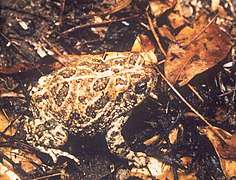 A living Anaxyrus cognatus (formerly Bufo cognatus), or Great Plains toad
A living Anaxyrus cognatus (formerly Bufo cognatus), or Great Plains toad - †Bufo hemiophrys
- †Bufo hibbardi
- †Bufo marinus
- †Bufo pliocompactilis – type locality for species
- †Bufo valentinensis
- †Bufo woodhousei
- †Buisnictis
- †Buisnictis breviramus – type locality for species
- †Buisnictis schoffi
C
- †Calippus
- †Calippus large informal
- †Calippus martini
- †Calippus regulus
- †Camelops
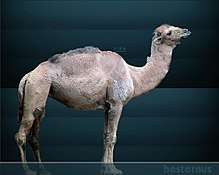 Life restoration of the Pliocene-Holocene camel Camelops
Life restoration of the Pliocene-Holocene camel Camelops - Candona
- †Candona lactea – or unidentified comparable form
- †Candona nyensis
- †Candona truncata
- Canis
- †Canis armbrusteri
- †Canis dirus
- †Canis edwardii
- †Canis ferox
- †Canis latrans
- †Canis lepophagus
- †Capromeryx
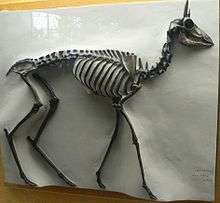 Fossilized skeleton of the Pleistocene dwarf pronghorn Capromeryx
Fossilized skeleton of the Pleistocene dwarf pronghorn Capromeryx- †Capromeryx furcifer
- †Carpocyon
- †Carpocyon compressus
- Carychium
- Castor
- †Castor canadensis
- †Castoroides
- †Castoroides ohioensis – or unidentified comparable form
- †Catostomus
- †Catostomus commersoni
- Celtis
- †Celtis willistonii
- †Ceratogaulus
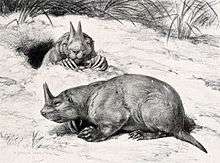 Life restoration of the Miocene-Pleistocene horned gopher Ceratogaulus. Robert Bruce Horsfall (1913).
Life restoration of the Miocene-Pleistocene horned gopher Ceratogaulus. Robert Bruce Horsfall (1913).- †Ceratogaulus hatcheri
- †Ceratogaulus minor
- †Cervalces
- Cervus
- †Cervus elaphus
- Chaetodipus
- †Chaetodipus hispidus
- Chara
- †Chara globularis – or unidentified comparable form
- †Chasmaporthetes
 Fossilized cranium of the Pliocene-Pleistocene hyena Chasmaporthetes
Fossilized cranium of the Pliocene-Pleistocene hyena Chasmaporthetes - Chelydra
- †Chelydra serpentina
- Chrysemys
- †Chrysemys picta
- †Chrysemys scripta
- †Cionella
- †Cionella lubrica
- Clethrionomys
- †Clethrionomys gapperi
- Cnemidophorus
- †Cnemidophorus bilobatus
- †Cnemidophorus sexlineatus
- Coluber
- †Coluber constrictor
- †Copemys – type locality for genus
- †Copemys pisinnus
- †Copemys shotwelli – type locality for species
- †Cosoryx
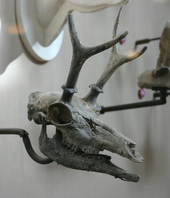 Fossilized skull of the Miocene pronghorn Cosoryx
Fossilized skull of the Miocene pronghorn Cosoryx- †Cosoryx furcatus
- Crotalus
- †Cryptantha
- †Cryptantha auriculata
- Cryptotis
- †Cryptotis adamsi
- †Cryptotis kansasensis – type locality for species
- †Cryptotis meadensis – type locality for species
- †Cryptotis parva
- Cynomys
- †Cynomys gunnisoni – or unidentified comparable form
- †Cynomys hibbardi – type locality for species
- †Cynomys ludovicianus
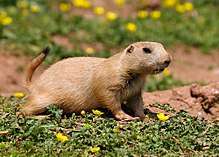 A living Cynomys ludovicianus, or black-tailed prairie dog
A living Cynomys ludovicianus, or black-tailed prairie dog - †Cynomys niobrarius
- †Cynomys spenceri
- †Cynomys vetus – type locality for species
- Cyprideis
- †Cyprideis littoralis
- Cyprinotus – tentative report
D
- Deroceras
- †Deroceras aenigma
- Diadophis
- †Diadophis punctatus
- †DinohippusMounted fossilized skeleton of the Miocene-Pliocene horse Dinohippus
- †Dinohippus interpolatus
- †Dinohippus leidyanus
- Dipodomys
- †Dipodomys hibbardi – type locality for species
- †Dipodomys ordii – or unidentified comparable form
- †Dipoides
- †Dipoides rexroadensis – type locality for species
- †Dipoides wilsoni – type locality for species
- Discus
- †Discus cronkhitei
- †Domninoides
- †Domninoides mimicus – type locality for species
E
- Egretta
- Elaphe – type locality for genus
- †Elaphe kansensis – type locality for species
- †Elaphe obsoleta
- †Elaphe vulpina
- Emydoidea
- †Emydoidea twentei
- †Epicyon
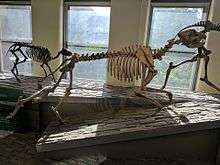 Mounted fossilized skeleton of the Miocene bone-crushing dog Epicyon
Mounted fossilized skeleton of the Miocene bone-crushing dog Epicyon- †Epicyon aelurodontoides – type locality for species
- †Epicyon haydeni
- †Epicyon saevus
- Equus
- †Equus conversidens
- †Equus francisci
- †Equus giganteus – or unidentified comparable form
- †Equus niobrarensis
- †Equus scotti
- †Equus simplicidens
 Fossilized skeleton of the Pliocene-Pleistocene horse Equus simplicidens, also known as the Hagerman horse or American zebra
Fossilized skeleton of the Pliocene-Pleistocene horse Equus simplicidens, also known as the Hagerman horse or American zebra
- †Eucastor
- †Euconulus
- †Eucyon
- †Eucyon davisi
- Eumeces
- †Eumeces fasciatus
- †Eumeces hixsonorum – type locality for species
- †Eumeces obsoletus
- †Eumeces septentrionalis
- †Eumeces striatulus
- †Eumecoides
- †Eumecoides hibbardi
- †Eumecoides mylocoelus
F
G
- Gastrocopta
- †Gastrocopta armifera
- †Gastrocopta cristata
- †Gastrocopta tappaniana
- Geochelone
- Geomys
- †Geomys adamsi – type locality for species
- †Geomys bursarius
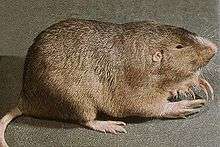 A living Geomys bursarius, or Plains pocket gopher
A living Geomys bursarius, or Plains pocket gopher - †Geomys jacobi – type locality for species
- †Geomys minor
- †Geomys quinni
- †Geomys tobinensis
- Gerrhonotus
- †Gerrhonotus mungerorum – type locality for species
- †Gigantocamelus
- †Gigantocamelus spatulus
- †Gnathabelodon
- †Gnathabelodon thorpei – type locality for species
- †Gomphotherium
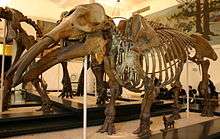 Mounted fossilized skeleton of the Miocene-Pleistocene elephant relative Gomphotherium
Mounted fossilized skeleton of the Miocene-Pleistocene elephant relative Gomphotherium - Gopherus
- Graptemys
- †Graptemys geographica
- Grus
- †Grus americana
- †Grus nannodes – type locality for species
- †Guildayomys
- †Guildayomys hibbardi
- Gyraulus
H
- Hawaiia
- †Hawaiia miniscula
- †Hawaiia minuscula
- Helicodiscus
- †Helicodiscus paralellus
- †Helicodiscus parallelus
- Helisoma
- †Helisoma anceps
- †Helisoma lentum
- †Helisoma trivolvis
- †Hemiauchenia
 Fossilized lower jaw of the Miocene-Pleistocene llama relative Hemiauchenia
Fossilized lower jaw of the Miocene-Pleistocene llama relative Hemiauchenia- †Hemiauchenia macrocephala
- †Hesperoscalops
- †Hesperoscalops rexroadi – type locality for species
- †Hesperoscalops sewardensis – type locality for species
- †Hesperotestudo
- †Hesperotestudo orthopygia
- †Hesperotestudo riggsi
- Heterodon
- †Heterodon nasicus
- †Heterodon platyrhinos
- †Heterodon plionasicus
- †Hibbardomys
- †Hibbardomys fayae – type locality for species
- †Hibbardomys marthae
- †Hibbardomys voorhiesi
- †Hipparion
- †Hipparion tehonense – or unidentified comparable form
- †Hippotherium
- Holbrookia
- †Holmesina
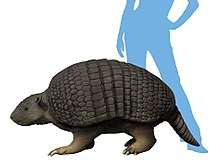 Life restoration of the Pleistocene armadillo relative Holmesina with a human to scale
Life restoration of the Pleistocene armadillo relative Holmesina with a human to scale- †Holmesina septentrionalis
- Homo
- †Homotherium
- †Homotherium serum
- Hyla
- †Hyla cinerea – or unidentified comparable form
- †Hyla gratiosa – or unidentified comparable form
- †Hyla squirella – or unidentified comparable form
- †Hyla versicolor
- †Hypohippus
 Life restoration of the Miocene horse Hypohippus. Heinrich Harder (1920).
Life restoration of the Miocene horse Hypohippus. Heinrich Harder (1920). - †Hypolagus
- †Hypolagus regalis – type locality for species
- †Hypolagus ringoldensis
- †Hypolagus vetus
- †Hypolagus voorhiesi
- †Hystricops
I
- Ictalurus
- †Ictalurus lambda
- †Ictalurus melas
- †Ictalurus punctatus
- †Ictiobus
 Illustration of a living Ictiobus, or buffalo fish
Illustration of a living Ictiobus, or buffalo fish - Ilyocypris
- †Ilyocypris bradyi
- †Ischyrocyon – tentative report
K
- †Kansasimys
- †Kansasimys dubius
- Kinosternon
- †Kinosternon flavescens
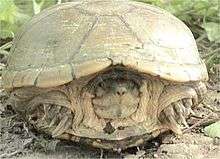 A living Kinosternon flavescens, or yellow mud turtle
A living Kinosternon flavescens, or yellow mud turtle - †Kinosternon subrubrum
L
- Lampropeltis
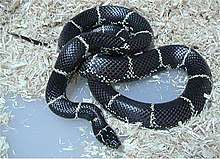 A living Lampropeltis getula, or eastern kingsnake
A living Lampropeltis getula, or eastern kingsnake- †Lampropeltis calligaster
- †Lampropeltis doliata
- †Lampropeltis getulus
- †Lampropeltis similis
- Lasiurus
- †Lasiurus cinereus
- †Lasiurus fossilis – type locality for species
- †Lasiurus golliheri – type locality for species
- Lepisosteus
- †Lepisosteus osseus
- †Lepisosteus platostomus – tentative report
 Illustration of a living Lepisosteus platostomus, or shortnose gar
Illustration of a living Lepisosteus platostomus, or shortnose gar
- Lepomis
- †Lepomis cyanellus
- †Lepomis humilis – or unidentified comparable form
- †Leptarctus
- †Leptarctus mummorum – type locality for species
- †Leptarctus woodburnei – type locality for species
- †Leptarctus wortmani – type locality for species
- †Leptocyon
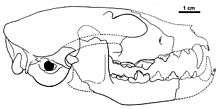 Illustration of a fossilized skull of the Oligocene-Miocene dog Leptocyon
Illustration of a fossilized skull of the Oligocene-Miocene dog Leptocyon- †Leptocyon vafer
- Lepus
- †Lepus californicus – or unidentified comparable form
- †Longirostromeryx
- Lontra
- †Lontra canadensis
- Lymnaea
- †Lymnaea caperota
- †Lymnaea humulus
- †Lymnaea parva
- Lynx
M
- †Machairodus
- †Machairodus catocopis
- Macrochelys
- †Macrochelys temminckii
- †Macrognathomys
- †Mammut
- †Mammut americanum
- †Mammuthus
- †Mammuthus columbi
 Life restoration of a herd of Mammuthus columbi, or Columbian mammoths. The extent of the fur depicted is hypothetical. Charles R. Knight (1909).
Life restoration of a herd of Mammuthus columbi, or Columbian mammoths. The extent of the fur depicted is hypothetical. Charles R. Knight (1909).
- Martes
- †Martes foxi – type locality for species
- †Martes stirtoni – type locality for species
- †Martinogale
- †Martinogale alveodens
- †Megalonyx
- †Megalonyx jeffersonii
- †Megalonyx leptostomus
- †Megantereon
- †Megantereon hesperus
- †Megatylopus
- †Megatylopus cochrani
- †Megatylopus gigas
- †Megatylopus matthewi
- †Menetus
- †Menetus exacuous
- Mephitis
- †Mephitis mephitis – tentative report
- †Mephitis rexroadensis – type locality for species
- †Merychyus
- †Merychyus novomexicanus
- Micropterus
- †Micropterus punctulatus – or unidentified comparable form
- Microtus
- †Microtus llanensis
- †Microtus meadensis
- †Microtus ochrogaster
- †Microtus paroperarius – type locality for species
- †Microtus pennsylvanicus
- Mictomys
- †Mictomys borealis
- †Mictomys kansasensis
- †Mictomys meltoni
- †Mictomys vetus
- †Minytrema – tentative report
- †Mionictis
- Musculium
- †Musculium partineium
- †Musculium transversum
- Mustela
- †Mustela erminea – or unidentified comparable form
- †Mustela frenata – or unidentified comparable form
- †Mustela meltoni – type locality for species
- †Mustela rexroadensis – type locality for species
- †Mustela vison
- †Mylagaulus
- †Mylagaulus sesquipedalis – type locality for species
- †Mylohyus
 Fossilized skeleton of the Pliocene-Holocene peccary Mylohyus
Fossilized skeleton of the Pliocene-Holocene peccary Mylohyus- †Mylohyus fossilis
- Myotis
N
- †NannippusPartial fossilized mandible of the Miocene-Pliocene horse Nannippus
- †Nannippus lenticularis
- †Nannippus peninsulatus
- †Nassella
- †Nassella pohlii
- †Nassella reynoldsii
- †Nebraskomys
- †Nebraskomys mcgrewi
- †Nebraskomys rexroadensis
- †Nekrolagus
- †Nekrolagus progressus – type locality for species
- Neofiber
- †Neofiber leonardi – type locality for species
- †Neohipparion
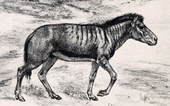 Life restoration of a herd of Neohipparion. Robert Bruce Horsfall (1913).
Life restoration of a herd of Neohipparion. Robert Bruce Horsfall (1913).- †Neohipparion affine – or unidentified comparable form
- †Neohipparion eurystyle
- †Neohipparion leptode
- †Neohipparion trampasense
- Neotoma
- †Neotoma floridana – or unidentified comparable form
- †Neotoma leucopetrica
- †Neotoma micropus
- †Neotoma quadriplicata – type locality for species
- †Neotoma sawrockensis – type locality for species
- †Neotoma taylori – type locality for species
- Nerodia
- †Nerodia hillmani
- †Nerodia sipedon
- †Nerterogeomys
- †Nerterogeomys smithi
- Nesovitrea
- †Nesovitrea electrina
- Nettion
- †Nettion ogallalae – type locality for species
- †Nimravides
- †Nimravides thinobates
- †Nothrotheriops
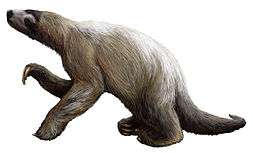 Life restoration of the Pleistocene ground sloth Nothrotheriops
Life restoration of the Pleistocene ground sloth Nothrotheriops- †Nothrotheriops texanus
- Notiosorex
- †Notiosorex crawfordi
- †Notiosorex jacksoni – type locality for species
- †Notolagus
- †Notolagus lepusculus – type locality for species
- †Notropes
- †Notropis – tentative report
O
- Odocoileus
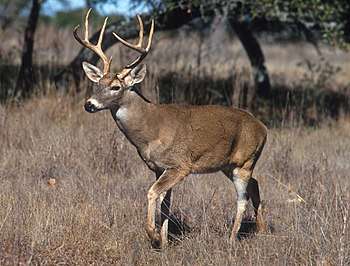 A living Odocoileus deer
A living Odocoileus deer - Ogmodontomys
- †Ogmodontomys poaphagus – type locality for species
- †Ogmodontomys sawrockensis – type locality for species
- †Ogmophis
- †Ogmophis pliocompactus – type locality for species
- Ondatra
- †Ondatra annectens
- †Ondatra idahoensis
- †Ondatra meadensis
- †Ondatra zibethicus
- Onychomys
- †Onychomys gidleyi – type locality for species
- †Onychomys hollisteri – type locality for species
- †Onychomys leucogaster – or unidentified comparable form
- †Onychomys martini
- †Onychomys pedroensis
- Ophisaurus
- †Ophisaurus attenuatus
- Ortalis
_(8629080871)_cropped.jpg) A living Ortalis, or chachalaca
A living Ortalis, or chachalaca- †Ortalis affinis – type locality for species
- Oryzomys
- †Oryzomys palustris
P
- †Paenemarmota
- †Paenemarmota barbouri
- †Paenemarmota sawrockensis
- †Paleoheterodon
- †Panicum
- †Panicum elegans
- Panthera
- †Panthera leo
- †Paracryptotis
- †Paracryptotis rex – type locality for species
- †Paramylodon
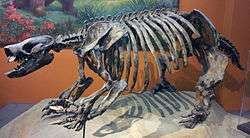 Fossilized skeleton of the Pliocene-Pleistocene ground sloth Paramylodon
Fossilized skeleton of the Pliocene-Pleistocene ground sloth Paramylodon- †Paramylodon harlani
- †Paranasua – or unidentified comparable form
- †Parapliosaccomys
- †Parapliosaccomys hibbardi
- †Pediomeryx
- †Pediomeryx hemphillensis
- †Peraceras
- Perca
- †Perca flavescens
- Perognathus
 A living Perognathus pocket mouse
A living Perognathus pocket mouse- †Perognathus coquorum – or unidentified comparable form
- †Perognathus dunklei – type locality for species
- †Perognathus gidleyi
- †Perognathus mclaughlini – type locality for species
- †Perognathus pearlettensis – type locality for species
- †Perognathus rexroadensis – type locality for species
- Peromyscus
- †Peromyscus baumgartneri – type locality for species
- †Peromyscus berendsensis
- †Peromyscus cochrani – type locality for species
- †Peromyscus cragini
- †Peromyscus kansasensis – type locality for species
- †Peromyscus progressus – type locality for species
- †Petenyia
- †Petenyia concisa
- Phenacomys
- †Phenacomys intermedius – or unidentified comparable form
- Phrynosoma
- †Phrynosoma cornutum
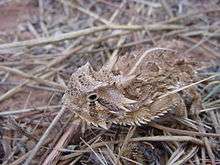 A living Phrynosoma cornutum, or Texas horned lizard
A living Phrynosoma cornutum, or Texas horned lizard
- Physa
- †Physa anatina
- †Physa arboreus
- †Physa gyrina
- †Physa hawni
- Pisidium
- †Pisidium abditum
- †Pisidium compressum
- †Pisidium noveboracense
- Pituophis
- †Planisorex
- †Planisorex dixonensis
- †Planorbula
- †Planorbula campestris
- †Platybelodon
 Mounted fossilized skeleton of the Miocene elephant relative Platybelodon
Mounted fossilized skeleton of the Miocene elephant relative Platybelodon- †Platybelodon loomisi
- †Platygonus
- †Platygonus bicalcaratus
- †Platygonus compressus – or unidentified comparable form
- †Platygonus pollenae
- †Platygonus vetus – or unidentified comparable form
- Plegadis – or unidentified comparable form
- †Pleiolama
- †Pleiolama vera – type locality for species
- †Plesiogulo
- †Plesiogulo marshalli – type locality for species
- †Plioctomys
- †Plioctomys rinkeri
- †Pliogyps – type locality for genus
- †Pliogyps fisheri – type locality for species
- †Pliohippus
 Fossilized skull of the Miocene horse Pliohippus
Fossilized skull of the Miocene horse Pliohippus- †Pliohippus nobilis – type locality for species
- †Pliohippus pernix
- †Pliolemmus
- †Pliolemmus antiquus – type locality for species
- †Pliophenacomys
- †Pliophenacomys dixonensis – type locality for species
- †Pliophenacomys finneyi
- †Pliophenacomys meadensis
- †Pliophenacomys osborni
- †Pliophenacomys primaevus – type locality for species
- †Pliopicus – type locality for genus
- †Pliopicus brodkorbi – type locality for species
- †Pliotaxidea
- †Pliotaxidea nevadensis
- †Pomoxis
- †Potamocypris
- †Pratifelis
- †Pratifelis martini – type locality for species
- †Pratilepus
- †Pratilepus kansasensis – type locality for species
- †Procamelus
- †Procastoroides
- †Procastoroides sweeti
- Procyon
- †Procyon lotor
- †Procyon rexroadensis – type locality for species
- †Prodipodomys
- †Prodipodomys centralis
- †Prodipodomys griggsorum
- †Prodipodomys kansensis
- †Prodipodomys tiheni
- †Prodipoides
- †Prodipoides phillisi – type locality for species
- †Prolappula
- †Prolappula verrucosa
- †Prolithospermum
- †Prolithospermum johnstonii
- †Prosthennops
- †Prosthennops serus – type locality for species
- †Protohippus
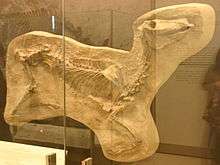 Fossilized skeleton of the Miocene horse Protohippus
Fossilized skeleton of the Miocene horse Protohippus- †Protohippus gidleyi
- †Protohippus supremus
- †Protolabis
- Pseudacris
- †Pseudacris clarki – or unidentified comparable form
- †Pseudacris triseriata
- Pseudemys
- †Pseudemys hibbardi
- †Pseudhipparion
- †Pseudoceras
- †Pseudoceras skinneri
- Puma
- †Puma concolor
- Pupilla
- †Pupilla sinistra
- Pupoides
- †Pupoides marginatus
R
- †Ramoceros
 Life restoration of the Miocene-Pliocene pronghorn Ramoceros and Cosoryx. Robert Bruce Horsfall (1913).
Life restoration of the Miocene-Pliocene pronghorn Ramoceros and Cosoryx. Robert Bruce Horsfall (1913).- †Ramoceros osborni
- †Rana
- †Rana areolata – or unidentified comparable form
- †Rana bucella
- †Rana catesbeiana
- †Rana fayeae
- †Rana parvissima
- †Rana pipiens
- †Rana rexroadensis
- †Regina
- †Regina grahami
- Reithrodontomys
- †Reithrodontomys humulis
- †Reithrodontomys megalotis
- †Reithrodontomys montanus – or unidentified comparable form
- †Reithrodontomys moorei
- †Reithrodontomys pratincola – type locality for species
- †Reithrodontomys rexroadensis – type locality for species
- †Reithrodontomys wetmorei – type locality for species
- Rhinocheilus – tentative report
- †Rhinocheilus lecontei
- †Rhynchotherium
 Restoration of the Miocene-Pliocene elephant relative Rhynchotherium
Restoration of the Miocene-Pliocene elephant relative Rhynchotherium
S
- †Satherium
- Scalopus
- †Scalopus aquaticus
- Scaphiopus
 A living Scaphiopus, or North American spadefoot toad
A living Scaphiopus, or North American spadefoot toad- †Scaphiopus hardeni
- Sceloporus
- †Sceloporus robustus – type locality for species
- †Sceloporus undulatus
- †Semotilus
- †Semotilus atromaculatus – or unidentified comparable form
- Sigmodon
- †Sigmodon curtisi – or unidentified comparable form
- †Sigmodon minor
- Sistrurus
- †Sistrurus catenatus
- †Smilodon
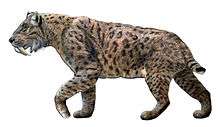 Life restoration of the Pleistocene-Holocene saber-tooth cat Smilodon
Life restoration of the Pleistocene-Holocene saber-tooth cat Smilodon - †Soergelia
- †Soergelia mayfieldi – or unidentified comparable form
- Sorex
- †Sorex arcticus
- †Sorex cinereus
- †Sorex cudahyensis
- †Sorex kansasensis – type locality for species
- †Sorex lacustris
- †Sorex leahyi – type locality for species
- †Sorex megapalustris
- †Sorex palustris
- †Sorex pratensis
- †Sorex rexroadensis – type locality for species
- †Sorex sandersi – type locality for species
- †Sorex scottensis – type locality for species
- †Sorex taylori – type locality for species
- Spea
- †Spea bombifrons
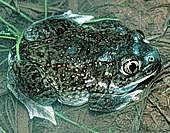 A living Spea bombifrons, or plains spadefoot toad
A living Spea bombifrons, or plains spadefoot toad - †Spea diversus
- Spermophilus
- †Spermophilus boothi
- †Spermophilus cragini – type locality for species
- †Spermophilus franklinii – or unidentified comparable form
- †Spermophilus fricki
- †Spermophilus howelli – type locality for species
- †Spermophilus lorisrusselli – type locality for species
- †Spermophilus meadensis – type locality for species
- †Spermophilus rexroadensis – type locality for species
- †Spermophilus richardsonii
- †Spermophilus tridecemlineatus
- Sphaerium
- †Sphaerium simile
- Spilogale
- †Spilogale putorius
- †Spilogale rexroadi – type locality for species
- Stagnicola
- †Stagnicola caperata
- †StegomastodonMounted fossilized skeleton of the Pliocene-Pleistocene elephant relative Stegomastodon
- †Stegomastodon mirificus
- †Stegomastodon primitivus
- †Stenotrema
- †Stenotrema leai
- Sternotherus
- Storeria
- †Storeria dekayi – or unidentified comparable form
- Succinea
- †Succinea ovalis
- †Succinia
- †Succinia concordalis
- †Succinia haydeni
- Sylvilagus
- †Sylvilagus floridanusA living Sylvilagus floridanus, or eastern cottontail
- †Symmetrodontomys
- †Symmetrodontomys simplicidens – type locality for species
- Synaptomys
- †Synaptomys australis
T
- Tapirus
- Taxidea
- †Taxidea taxus
- †Teleoceras
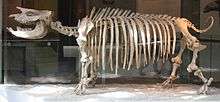 Mounted fossilized skeleton of the Miocene-Pliocene rhinoceros Teleoceras
Mounted fossilized skeleton of the Miocene-Pliocene rhinoceros Teleoceras- †Teleoceras fossiger – type locality for species
- †Teleoceras guymonense
- Terrapene
- †Terrapene carolina
- †Terrapene ilanensis
- †Texasophis
- †Texasophis wilsoni – type locality for species
- †Texoceros
- †Texoceros guymonensis – or unidentified comparable form
- Thamnophis
- †Thamnophis proximus
- †Thamnophis radix
 A living Thamnophis radix, or plains garter snake
A living Thamnophis radix, or plains garter snake - †Thamnophis sauritus – or unidentified comparable form
- †Thamnophis sirtalis
- Thomomys
- †Thomomys talpoides
- Trachemys
- †Trachemys scripta
- †Tregobatrachus – type locality for genus
- †Tregobatrachus hibbardi – type locality for species
- †Tregophis – type locality for genus
- †Tregophis brevirachis – type locality for species
- †Tregosorex
- †Tregosorex holmani – type locality for species
- †Trigonictis
- Trionyx
- †Trionyx spinifer
- Tropidoclonion
- †Tropidoclonion lineatum
- Tympanuchus – or unidentified comparable formA living Tympanuchus, or prairie chicken
U
- †Untermannerix
- †Untermannerix copiosus
- Urocyon
- †Urocyon cinereoargenteus
.jpg) A living Urocyon cinereoargenteus, or gray fox
A living Urocyon cinereoargenteus, or gray fox - †Urocyon progressus
- †Ustatochoerus
- †Ustatochoerus medius
Z
- Zapus
- †Zapus burti – type locality for species
- †Zapus hudsonius
 A living Zapus hudsonius, or meadow jumping mouse
A living Zapus hudsonius, or meadow jumping mouse - †Zapus rinkeri – type locality for species
- †Zapus sandersi – type locality for species
- Zonitoides
gollark: Hmm, I wonder if I can horribly abuse z3 for collatz like I abused it for mazes.
gollark: But for applications where you know n < 2^64 you can just hardcode it yourself if you care.
gollark: Why would they special-case collatzen?
gollark: Hahahahahahahano.
gollark: Excellent, GTech™ apio{REDACTED} successful.
References
- Various Contributors to the Paleobiology Database. "Fossilworks: Gateway to the Paleobiology Database". Retrieved 7 August 2017.
This article is issued from Wikipedia. The text is licensed under Creative Commons - Attribution - Sharealike. Additional terms may apply for the media files.

